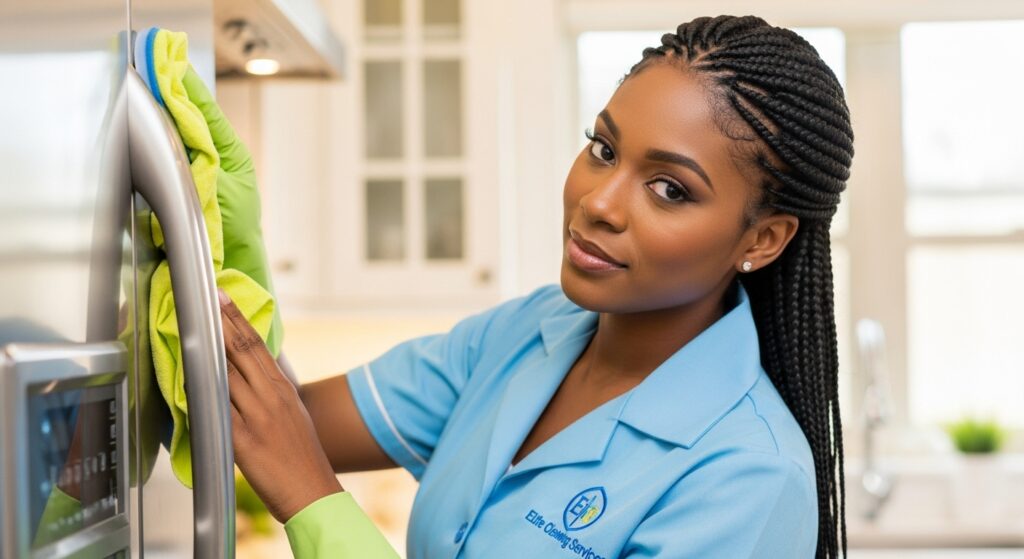Start With a Clean Slate
One of the most important professional house cleaning tips that I learned from professional cleaners is to always start with a clean slate—and that doesn’t just mean wiping down surfaces. Before you can actually clean, you need to declutter. Clear off counters, move stray shoes, fold the laundry sitting on the couch—remove any visual noise. Once that’s done, begin with a quick dust through the space to prevent particles from settling after you’ve already finished mopping or wiping. This habit saves both effort and frustration. I recommend creating a simple checklist for each space. It keeps you focused and ensures you don’t skip essential steps when things get busy.
Another professional tip I’ve picked up is to clean clockwise around each room. It might sound unnecessary, but this method is part of many teams’ operating procedures for a reason—it works. It creates a routine that your brain follows without second-guessing, which saves mental energy and keeps you from missing spots. Whether you’re deep cleaning or just doing your weekly planning, sticking to a direction helps maximize cleaning time and builds consistency. Trust me, once you apply this system, you’ll notice your entire process becoming smoother and more efficient.
Choose the Right Tools (Not More of Them)
One mistake I often see people make is collecting too many cleaning supplies. But professional cleaners know that having the right tools—not more of them—makes all the difference. Instead of crowding your cabinet with dozens of sprays and gadgets, stick with a few quality basics. A good multi-purpose cleaner, some melamine sponges (like those Magic Eraser substitutes), and a solid scrubbing brush can go a long way. Many pros even make their own DIY solutions using natural ingredients because they’re cheaper, safer, and work just as well.
I used to think I needed a different product for every room, but once I learned to pick the right essentials and let the cleaners do their job, it all got easier. Letting a product sit for 15 minutes on a surface saves you from scrubbing like crazy. And tools like microfiber cloths or sponges work especially well on stubborn stains like bathtub grime or dirty walls. The key is working smarter, not harder—just like the pros do.
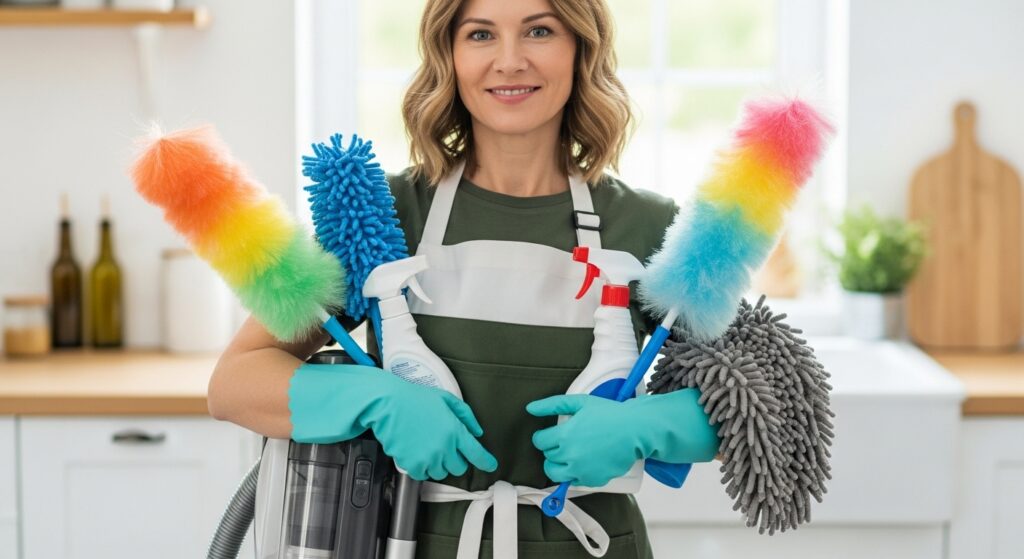
Let Products Do the Work
One of the biggest secrets professional cleaners use is to let products sit on the surface and act before starting to scrub. Instead of using elbow grease right away, let your cleaner do the heavy lifting. Whether it’s a store-bought solution or a DIY mix of vinegar and baking soda, giving it 15 minutes to penetrate grime saves energy and delivers better results. This “smarter not harder” approach works particularly well in areas with buildup—think kitchen sinks, bathroom tiles, or inside ovens. You’ll find that stains loosen up on their own, needing just a light wipe afterward.
When I clean professionally, I always keep a spray bottle of homemade natural cleaners ready. Here’s my go-to multipurpose mix: 1 cup of water, ½ cup of vinegar, 1 tablespoon of baking soda, and 10 drops of lemon essential oil. Shake it up and spray it generously. While it acts on greasy kitchen counters or inside the shower, I use the downtime to clean mirrors or vacuum rugs. This time-saving habit maximizes every cleaning session and avoids unnecessary scrubbing. It’s a simple switch, but it really adds up when you’re cleaning an entire house.
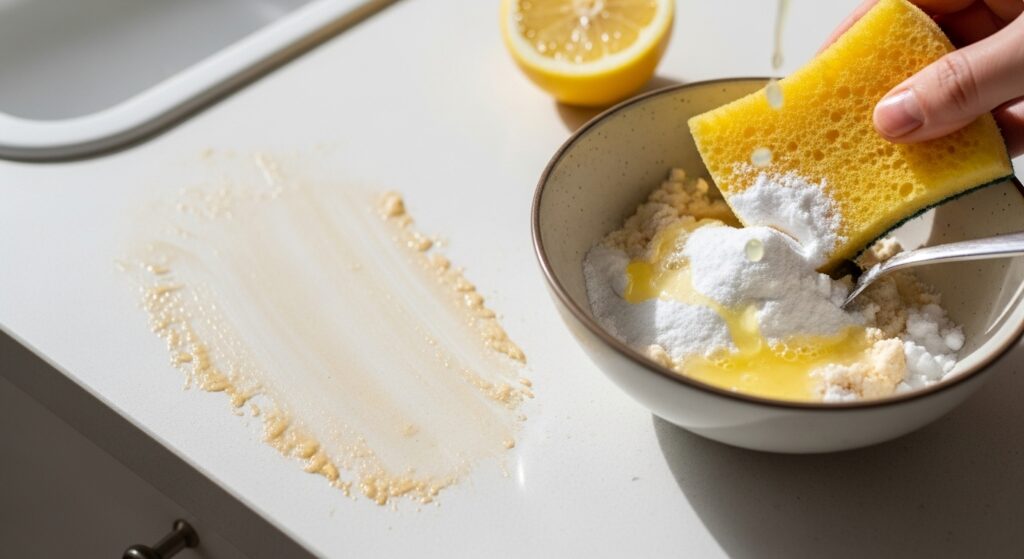
Target High-Impact Areas First
When time is limited, professionals know to focus on the areas that make the biggest visual and hygienic difference. Start in the kitchen, where food messes accumulate fast. Wipe countertops to remove crumbs, grease, and spills using a damp microfiber cloth and a bit of lemon-scented spray for a pleasant scent. A hand vacuum comes in handy for catching dry messes around appliances and cabinet corners. Pay special attention to the stove and sink—these two hotspots give the whole kitchen a cleaner feel once freshened up.
In the bathroom, speed and strategy go hand in hand. Hit the mirror first—streak-free glass instantly upgrades the space. Then scrub down the tub, toilet, and faucet areas. A Magic Eraser is especially useful for tackling soap scum and water buildup around sinks. Even if you’re short on time, swapping out used towels and neutralizing odors with a spritz of air freshener creates an impression of deep cleanliness. These small changes can make the room feel sanitized and refreshed in just a few minutes.
The living room often serves as the home’s centerpiece, so it deserves attention. Begin by gently dusting electronics, TV screens, and décor items with a dry microfiber cloth. Follow that up by wiping down glass surfaces, such as coffee tables or cabinet doors. Removing smudges from these areas makes the room appear brighter and more polished. Use a lint roller on fabric furniture to capture pet hair and crumbs—it’s a quick trick that makes a surprisingly big difference in how clean your home looks.
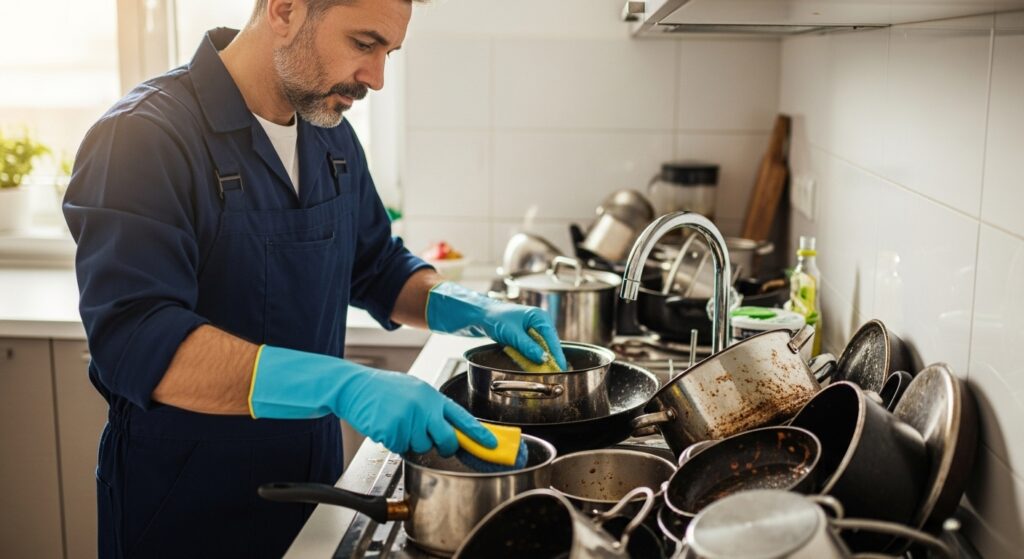
Hide the Clutter—Smartly
Clutter is the first thing that makes a space feel messy—even when everything is technically clean. That’s why professional cleaners often rely on a simple trick: using baskets to conceal loose items. A well-placed basket can hold books, remote controls, chargers, or toys that tend to accumulate on flat surfaces. It’s a quick way to make a room feel more tidy without needing to sort through everything on the spot. Fold a throw blanket neatly over the couch and fluff the pillows to give your space a composed, lived-in feel.
But baskets aren’t just about hiding things—they also help organize. Once your immediate cleaning is done, take a few extra minutes to fold clothes, stack unread mail, and corral odds and ends that were stashed out of place. This prevents the mess from creeping back in the next day. Think of it as a shortcut that creates the illusion of order while buying you time to sort it properly later. With a few simple movements, you can reset the entire tone of a room.
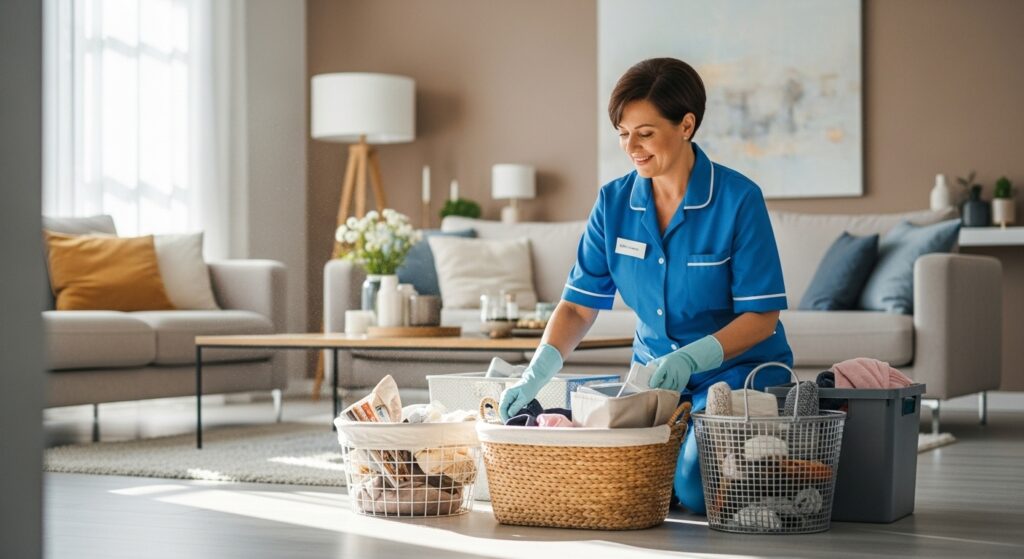
Use Steam & Natural Helpers
Sometimes the most effective cleaning tools are the simplest — and the most natural. I often reach for steam when tackling built-up grime. A handheld steamer paired with a microfiber cloth can loosen dirt on bathroom tiles, stovetops, and even inside the fridge without harsh chemicals. It’s a safe and surprisingly powerful way to clean that leaves surfaces gleaming.
For quick dusting and deodorizing, dryer sheets are a game-changer. I use them to wipe baseboards, fan blades, and even blinds — they catch dust effortlessly and leave a fresh scent behind. When it comes to shining faucets or cleaning the grill, I swear by the combo of lemon and vinegar. The lemon cuts grease and leaves a natural shine, while vinegar disinfects and deodorizes. These gentle helpers save time, money, and your indoor air quality.
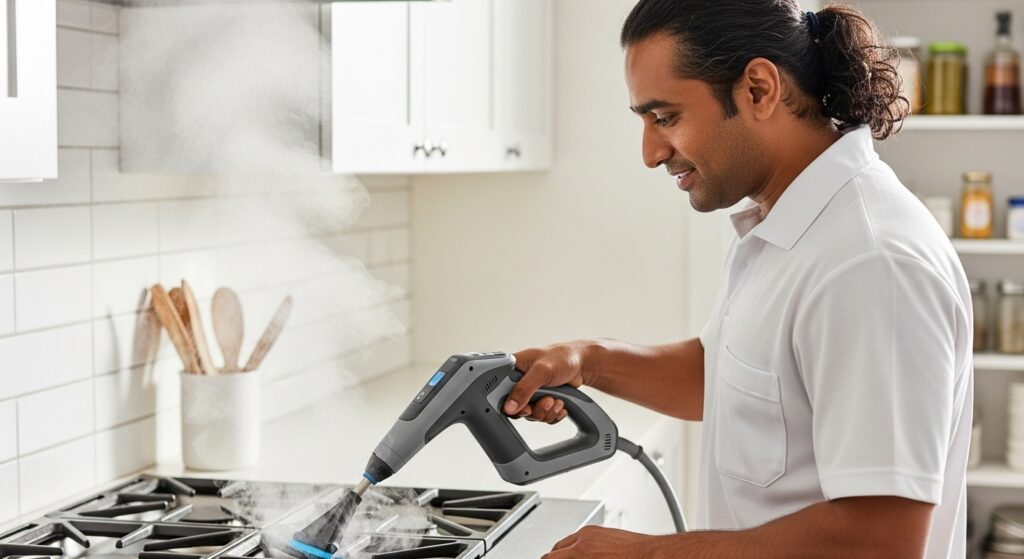
Don’t Forget Corners and Hidden Spots
Even the cleanest-looking home can hide dust in overlooked spaces. One thing I always remind my clients: pay close attention to corners, baseboards, and the areas under furniture. These spots quietly collect hair, dust, and crumbs—especially in homes with pets or kids. A regular vacuuming session isn’t enough unless you specifically target these neglected zones.
To stay on top of it, I keep a slim vacuum attachment on hand and take a few extra minutes each week to tidy these problem areas. Shifting furniture slightly can give you access without needing to rearrange your whole space. Keeping these spots clean makes a huge visual difference and ensures your entire home feels truly tidy, not just on the surface.
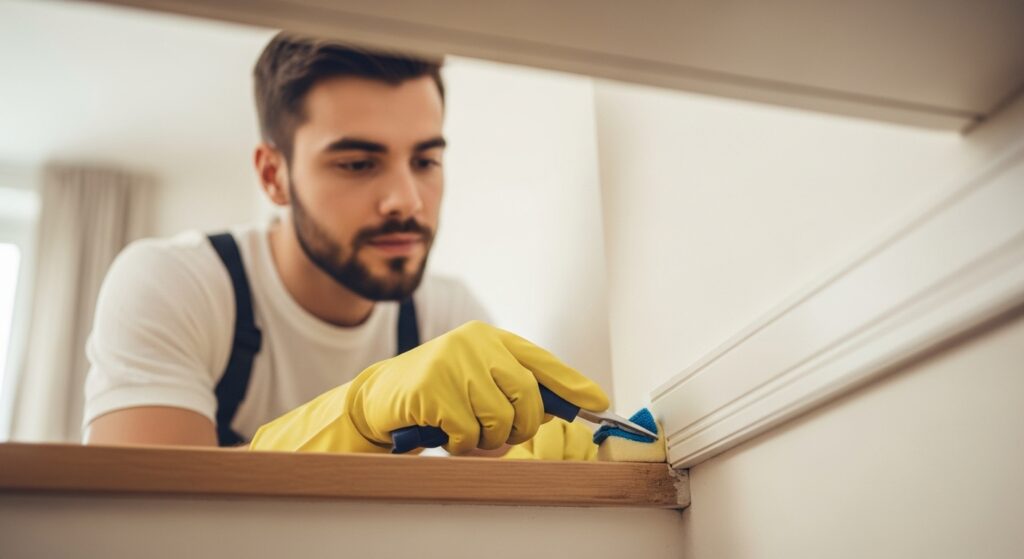
Light, Scent, and Atmosphere
A truly clean home doesn’t just look spotless—it feels fresh. One of the fastest ways to elevate your space is to let in natural light. Opening the curtains first thing in the morning instantly lifts the mood of a room, making it feel bright and airy. It’s one of those finishing touches that professional cleaners never skip.
To go a step further, I always recommend lighting a candle with a light scent—think citrus, linen, or lavender. The goal isn’t to overpower but to create an inviting background aroma that quietly says, “this place is clean.” These small sensory cues might seem optional, but they’re what truly transform a house into a home after cleaning.

Mistakes to Avoid
Even seasoned homeowners fall into common cleaning traps, especially when it comes to mixing products. It might seem efficient to combine solutions like vinegar and castile soap, but doing so can cause the soap to revert into plain oil, making it completely ineffective. Worse, some combinations can trigger a dangerous reaction. Always stick to original product instructions unless you truly know what you’re doing.
Another often-overlooked mistake is using a regular vacuum instead of one with a HEPA filter. A standard vacuum might clean surfaces, but it can also recirculate dust and pollen, making air quality worse. For anyone with allergies or asthma, this is more than just inefficient—it’s harmful. Professional cleaners rely on HEPA-filtered models to capture fine particles and make the whole process far more effective. Don’t settle for less.
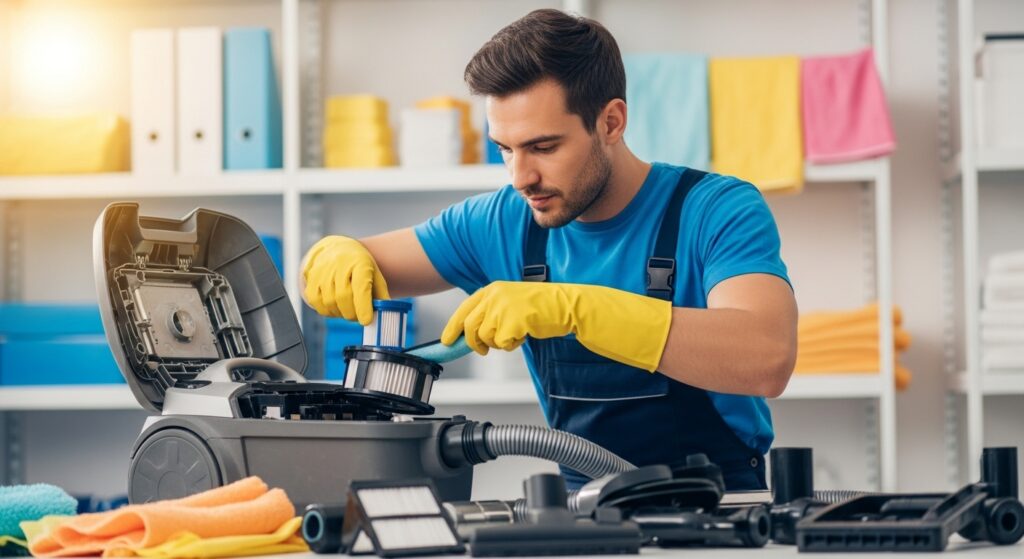
Conclusion
Cleaning your home like a pro isn’t about buying the most expensive products or spending hours scrubbing every corner. It’s about being smart, efficient, and intentional. From starting with a decluttered space to letting cleaners act on surfaces, using steam, and targeting high-impact zones like kitchens and bathrooms—professional methods can save you time and effort while making your home truly shine.
Pick just 2–3 strategies from this guide—whether it’s using a HEPA filter vacuum, swapping out chemical cleaners for vinegar and baking soda, or sticking to a simple checklist—and try them out today. You’ll quickly see how much easier and more effective cleaning can be.
What’s your favorite professional cleaning tip or go-to product? Share it in the comments!
FAQs: Pro-Level Answers to Your Cleaning Questions
1. What’s the biggest mistake people make when cleaning their homes?
One of the biggest mistakes is cleaning without a plan. Professional cleaners always follow a consistent routine—usually top to bottom, left to right—so they don’t miss spots or double their work.
2. How do professionals clean so fast and efficiently?
They rely on a combination of efficient tools, multi-surface products, and a structured checklist. They don’t waste time switching products or revisiting areas—each step is intentional and streamlined.
3. Are store-bought or homemade cleaners better?
Both have their place. Many pros prefer natural cleaners like vinegar, baking soda, and essential oils for everyday jobs. They’re effective, safer for families, and cheaper in the long run.
4. How often do professionals recommend cleaning each area of the house?
High-traffic areas like kitchens and bathrooms should be cleaned daily or several times a week, while bedrooms and living spaces can often be maintained with weekly deep cleans and daily tidying.
5. What tools do professionals never clean without?
Essentials include microfiber cloths, a good vacuum with attachments, a mop (or Swiffer WetJet), glass cleaner, and multi-purpose disinfectant spray. The right tools save both time and effort.
6. Can I clean like a pro even with a busy schedule?
Absolutely. Use timed cleaning blocks, focus on high-impact tasks, and stay consistent. With the right habits and tools, you can achieve pro-level results in less time than you think.

